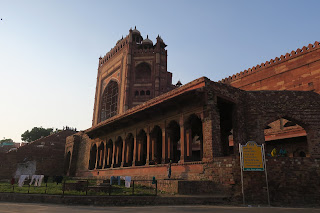The Tomb of Salim Chishti is famed as one of the finest examples of Mughal
architecture in India, built during the years 1580 and 1581, along with the
imperial complex at Fatehpur Sikri near Zenana Rauza and facing south towards
Buland Darwaza, within the quadrangle of the Jama Masjid which measures 350
ft. by 440 ft.
It enshrines the burial place of the Sufi saint, Salim Chisti (1478 – 1572), a
descendant of Khwaja Moinuddin Chishti of Ajmer, and who lived in a cavern on
the ridge at Sikri.
The mausoleum, constructed by Akbar as a mark of his respect for the Sufi
saint, who foretold the birth of Akbar's son, who was named Prince Salim after
the Sufi Saint and later succeeded Akbar to the throne of the Mughal Empire,
as Jahangir.
|
Approaching Jama Mosque.
Constructed by Mughal Emperor Akbar, it is one of the largest mosques in
India.
- It is the most sought after pilgrimage site by the devotees.
-
It is also one of the most visited tourist destinations in Agra
district.
-
Some of the designs of the mosque reflect beautiful Iranian
architecture.
|
|
Courtyard (Sahn).
The courtyard (sahn) is of dimensions 165 m by 130 m (541 ft by 426 ft).
- An ablution tank lies in its centre.
-
The courtyard's northern, southern, and eastern sides are lined by
arcades (dalans).
-
These are shaded by a continuous, projecting eave (chhajja), which is
supported by corbels.
- Chhatris top the parapets of these arcades.
-
The inner bay of the arcades is divided into cells (hujra), probably
used as sleeping quarters for devotees.
-
Towards the northern side of the courtyard are the Tomb of Salim
Chishti and the tomb of Islam Khan. The former is contrasted from the
red sandstone of the Jama Masjid complex by its wholesale use of
makrana marble.
- Underground water reservoirs lie beneath the courtyard.
|
|
High Gate (Buland Darwaza).
The northern and southern gates may have historically resembled each
other - however, in 1573 the southern gate was rebuilt by Akbar as the
High Gate (Buland Darwaza) to celebrate the success of his military
campaign in Gujarat.
-
It is the most prominent gate and a monument in itself, featuring
hallways and rooms over its many floors.
-
Asher says that it is more likely the gate was built to emphasise
Akbar's relationship with the Chishti Order.
|
|
Prayer Hall.
The rectangular prayer hall (dimensions 89 m by 20 m, 291 ft by 65 ft)
lies on the western end of the courtyard, facing Mecca in keeping with
Islamic tradition.
-
Its facade is dominated by a grand pishtaq, which contains three
arched entryways.
-
Three domes rise from the roof, corresponding to the three bays into
which the hall is divided.
-
The central bay is square and richly decorated, featuring geometric
marble inlays as well as polychrome floral paintings.
-
Its western wall bears ornate prayer niches (mihrabs), bordered by
mosaics and glazed tile.
-
The two side bays are colonnaded halls, each containing a square
chamber.
-
These halls contain their own decorated mihrabs, and are supported by
Hindu-style pillars.
-
At the extremities of the prayer hall are women's galleries (zenanas).
|
|
Tomb of Salim Chishti (left) and tomb of Islam Khan (right).
|
|
Tomb of Salim Chishti.
The Tomb of Salim Chishti is a mausoleum locating within the quadrangle
of the Jama Masjid.
-
It enshrines the burial place of the Sufi saint, Salim Chisti (1478 –
1572), a descendant of Baba Farid, and who lived in a cavern on the
ridge at Sikri.
-
Considered one of the finest examples of Mughal architecture in India,
the mausoleum was built during the years 1580 and 1581 by Akbar, along
with the imperial complex at Fatehpur Sikri near Zenana Rauza.
-
It was constructed as a mark of his respect for Salim Chisti, who
foretold the birth of Akbar's son (named Prince Salim after Salim
Chisti), who succeeded Akbar to the throne of the Mughal Empire.
|
See also
Sources
Location











